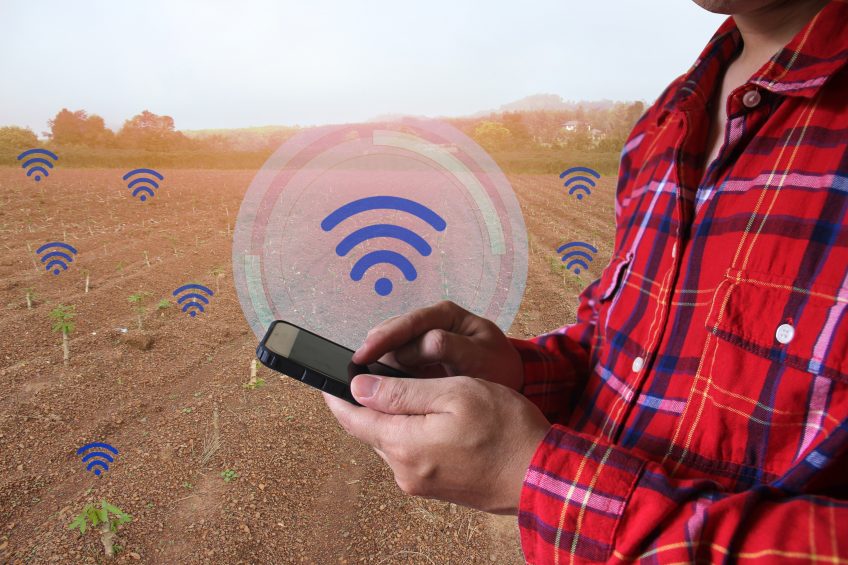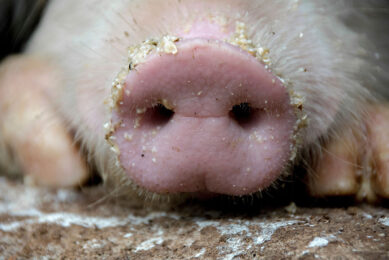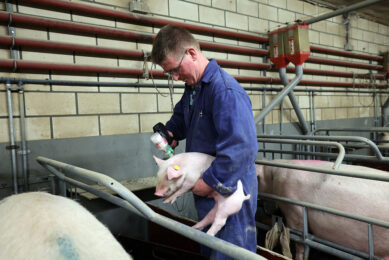Why precision farming takes its time with pigs

Pig Progress editor Vincent ter Beek attended a very interesting and relevant conference on Precision Livestock Farming (PLF). He learnt about why monitoring of individual finishing pigs can offer many opportunities – and why the industry seems hesitant to embrace the promising technology.
Did you know that finisher pigs in a barn can walk up to 4 km per day? And did you know that finisher pigs sometimes form couples while eating?
Perhaps you shrug, but to me it was new information that I heard at the European Conference for Precision Livestock Farming, held in Nantes, France, Sept 11-12. PLF as a modern technology has been around for quite some while now, and it comes down to the use of sensors and algorithms to closely figure out what is going on inside any livestock farm – and if necessary be alarmed to make management adjustments, e.g. by changing feed rations or call the vet.
Most papers were on cows
Roughly half of the conference’s papers were on dairy and beef production (37). The poultry industry, normally the most progressive and keen to innovate, can in in ‘last position’ this time with only 8 papers. Pigs finished half-way at 20 presentations.
The nature of PLF is what is at the bottom of this phenomenon. Essentially, it is all about animal identification, using eartags with Radio-Frequency Identification (RFID). In general cow herds per farm are not so large plus they can reside there for years on end, hence the investment in eartags can be a valuable tool to track what is going on with the animals.
Individual monitoring of animals
A poultry farm on the other hand has sometimes tens of thousands of birds. Broilers live up to 6 weeks, so individual monitoring of chickens is an illusion. That is why in poultry production, most attention goes out to monitoring groups, like e.g. flock weight, flock behaviour or flock feed/water consumption.

Pigs come somewhere in the middle of all that. Naturally, sows are worth the individual investment as they can serve for various years in breeding barns. Individual RFID tags have therefore become fairly common, especially in farms having Electronic Sow Feeding (ESF) systems in gestation. In finisher herds, however, although technically the individual tracking of pigs is feasible, group monitoring continues to be the standard.
Pig contributions at PLF conference
Not surprisingly, the pig contributions at the PLF conference roughly could be divided in these 2 directions. Either a researcher had focused on aspects of group behaviour, or they had chosen to follow individual animals.
A few forward-thinking researchers indeed have started to follow the individual finisher pigs, and it’s interesting to see what kind of results that yielded. For animals that are usually kept together as a group, I thought it was surprising to actually become aware of the fact that some pigs often seem to choose to eat simultaneously, as Anita Kapun of the University of Hohenheim, Germany, mentioned in her presentation.
(She hadn’t researched yet why as it was a side connotation in a much bigger research to behaviour and activity monitoring. She said perhaps they indeed like each other – or perhaps they spend much time in each other’s vicinity because they often fight. Or they are the drop-outs that always get chased away at the trough and start eating when it’s quiet.)

And I thought it was revealing that when given the space (24 pigs in a large room), pigs tend to walk up to 4 km/day, as conveyed by Brian Barnes, University of Nebraska-Lincoln, USA. This was confirmed by other researchers who had done similar observations.
No finisher pig is average
What I deduced from all this is that, despite a tremendous amount of research on pigs, there is quite a lot unknown about finisher pigs – and none of them has ‘average’ behaviour. Each pig can have a good day, or a bad day; each can develop lameness or grow less, all things that don’t get picked up by average figures.
One of the leading papers in this respect was the PhD study by Dr Jarissa Maselyne (2016), of the Flemish Institute for Agricultural and Fisheries Research (ILVO), Belgium, who followed series of finisher pigs and their eating behaviour in order to develop an early warning system for health problems.
Last year, Pig Progress reported already about the research of Jarissa Maselyne
If a finisher-specific management strategy could be realised, there is just so much to win, she told me.
How to get farmers interested?
Now that is where it gets funny, because developing something like that, let alone implementing it, costs money and requires investment, decent thinking, planning, conviction and belief. Quite a few presentations, however, touched on the question how to raise interest with farmers. The impression I got from a range of presentations is that from the side of producers, the interest from the farmer’s side is lower than many would have hoped.
PLF offers great opportunities and possibilities and yet for some reason the market just doesn’t seem to get it. What is going on?
Perception of innovation maturity
Geerte Paradies, a researcher from the Netherlands’ independent research organisation TNO, introduced the concept of ‘perception of innovation maturity’ to explain the phenomenon. In my own words: the technology would need time to convince producers’ hearts.
I’m not a researcher nor a swine producer, but let me make a few guesses as well.
- Pig farms are already full of technologies, often more than 10 companies are involved to supply troughs, ventilation, feeding supply, disease management, equipment, pigs etc. Adding more just adds another platform/supplier.
- Developments usually go fast. Whoever pioneered with an iPhone 6 a few years ago is today already old-fashioned. Investments in a fancy new system may become obsolete fairly quickly.
- Welfare, environmental and societal demands increase rapidly. By law, farmers are often compelled to prioritise major investments on-farm in times when economics aren’t that good anyway. Even if you’d have another bag of money on the shelve, would you think about yet another change?
- These systems produce data, loads of data. Help! What do I do with all of them? You know what, I’ll go and feed the pigs first.
- The harsh reality of pig farms is they are full of heavy clumsy animals that usually chew on anything that is in their way and perhaps they are a little bit incompatible with very innovative technology involving cameras, sensors and algorithms.
- Some of the PLF papers and presentations focused tremendously on the mathematical technology behind it. Is that the way to convince pig farmers to try?
Offering PLF inside a bigger platform
Adding it all up, I think PLF – be it on group level or if possible on an individual animal level – definitely has a world to win, but it should be offered to pig farmers in a different way.
When outcomes of these types of technology can be embedded in a bigger platform, the pig farmer doesn’t have to discover it or to heavily invest – it is just brought to him like a tool inside an existing platform, just like your smartphone allows you to download new apps. Maximus Ag Technologies in the USA has been offering this for a while and Fancom in the Netherlands has understood this well.
Chain approach
Another fascinating example is the initiative to establish IoF2020, the Internet of Food and Farm 2020, an EU supported programme bringing together the entire food production chain together using loads of data involving all stakeholders. This includes the European swine business.
That way not only traceability can be enhanced, but also pig farmers can see immediately when and where their pork chops are being sold.
Now there’s a way data turn into knowledge and money.
 Beheer
Beheer








 WP Admin
WP Admin  Bewerk bericht
Bewerk bericht